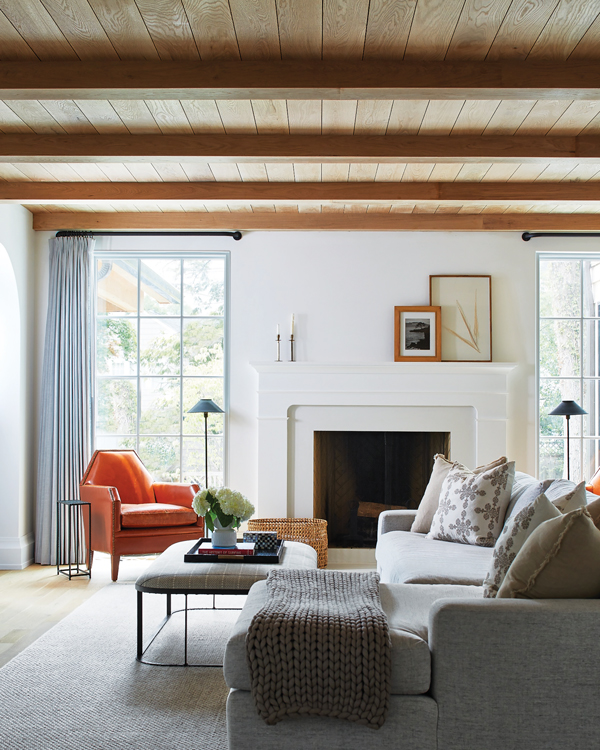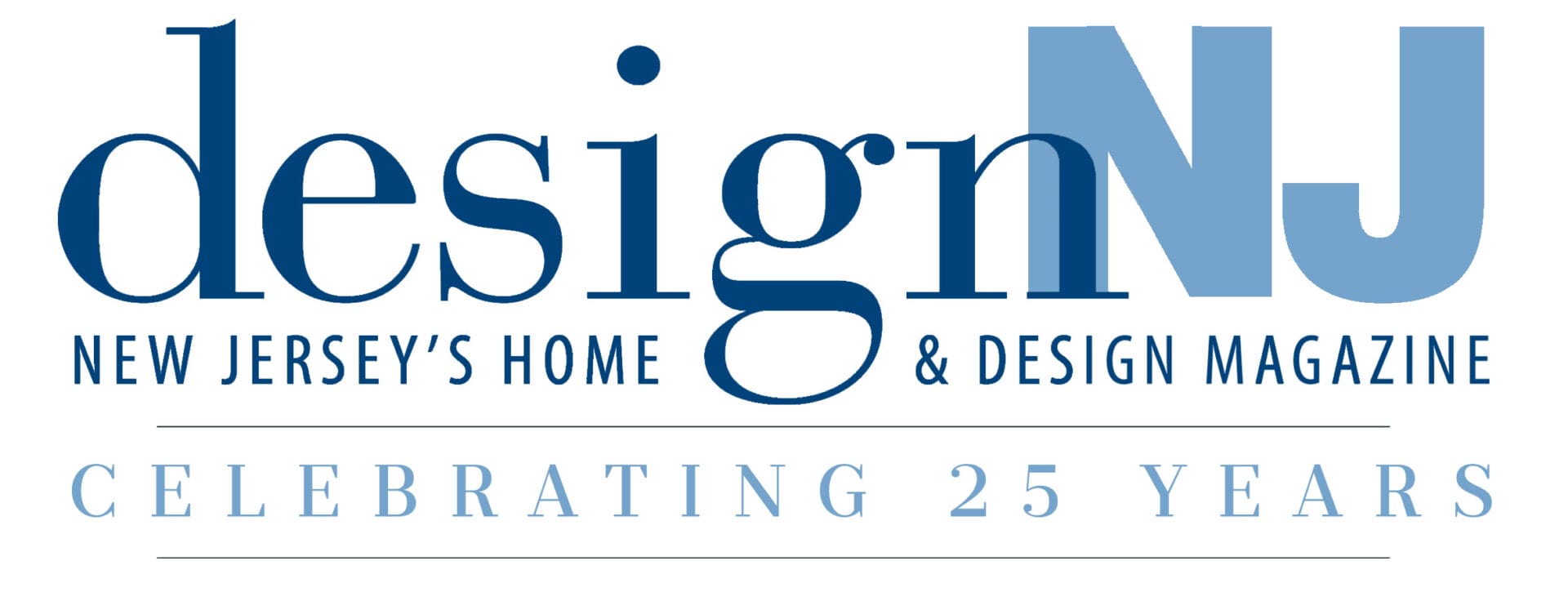One of a Kind
Writer Marirose Krall | Photographer Raquel Langworthy and Laura Moss | Architect Michael A. Moritz, AIA, LEED AP | Builder Michael R. Mroz | Location Westfield, NJ | Interior Design and Construction Consulting and Selections Ellie MrozA Westfield home features distinctive design

“The cedar and brick work with the arched doorway and the gas-lit copper lanterns to create a home that looks both fresh and classic,” builder Michael Mroz says. “The materials are living with the home and will age beautifully with it; the cedar will turn to silvery-gray over time.” Photo by Raquel Langworthy
Ellie and Michael Mroz might be familiar to you. The husband-and-wife team has appeared on NBC’s George to the Rescue, providing home renovations for deserving families. He is president and CEO of Michael Robert Construction; she is founder and principal designer of Ellie Mroz Design. The couple, both of whose firms are based in Westfield, New Jersey, work just as hard for their offscreen clientele. They, along with Michael Moritz of Stonewater Architecture in Summit, New Jersey, created this distinctive home in Westfield for their clients, Staci and Paul Acquasanta, to raise their family.

The staircase tower is bounded on two sides by walls of windows. “It looks magnificent when it’s lit up at night,” architect Michael Moritz says. Photo by Raquel Langworthy
THE BUILDER
DNJ: What materials were used to create the unique look of this home?
Michael Mroz: This is far from a typical new-construction home. Most of the features are custom. All the materials in this home are natural and will patina over time to create a fresh take on an Old World Spanish vibe. The oversized windows and the custom cedar shutters — which were built large enough to cover the windows like shutters in older homes — stand out against the painted brick, an element that’s rarely seen.
DNJ: Why was it decided to paint the brick rather than to leave it the natural color?
Michael Mroz: This was the plan from the start. The painted brick adds depth, texture and shadow lines that play well with the rest of the elements. We wanted this home to fit in with the older ones in the neighborhood, but we also wanted it to look classically fresh. Painted brick gave it an Old World, yet updated, feel that ties the exterior elements together.
DNJ: Did this project present any challenges? How did you address them?
Michael Mroz: The homeowners are super creative and have lots of interests. We wanted to meet their needs while building a home where the rooms were functional, had the right flow and were also aesthetically cohesive. The pub is a good example. It was a unique feature on the wish list, and we didn’t want it to feel like an afterthought. A room like this needs to be used — and used often! So its design involved careful planning to ensure optimal flow with the rest of the house. It connects to the wine room and the family room and also leads directly to a covered pergola and the rest of the outdoor space.
The pub is the furthest thing you would imagine when you conjure a new-construction bar. The 14-foot-high ceiling covered in antiqued-tin panels, various light sources, moody mural, rich marbles, herringbone floor with ebony border, and arched window all reflect a novel approach to an Old World aesthetic. Still, we didn’t sacrifice function: the window wall is doubly thick to allow for a recessed nook with industrial shelving to store glassware. And the bar is the real deal, with an industrial beer fridge and a full workstation with sink and storage.

Like the front of the home, the rear façade is swathed in wood and brick. “The covered porch has no corner columns, allowing for more expansive views. The chimney holds up the roof,” Michael Moritz says. Photo by Laura Moss
THE ARCHITECT
DNJ: What is the style of this home?
Michael Moritz: I always say, “You don’t start with a style; you end with one.” This was designed for a part of Westfield that has a lot of Tudor-style houses, and the Acquasantas wanted their new home to blend in but also to have a more modern look. They didn’t want stucco, so we used cedar trim and brick. It has a California Modern feel, with clean lines, minimal details and lots of glass.

“The exterior windows and doors have black frames for an industrial look,” Moritz says. Stacks of wood for the outdoor fireplace are stored behind iron bars — which complement the door trim — on each side of the French doors. Photo by Laura Moss
DNJ: The stairwell is in an unusual spot. Why did the homeowners make that choice?
Moritz: The owners didn’t want a center-hall colonial-style home. So we positioned the stairwell off to one side, next to the mudroom and the secondary entry. This gave us the opportunity to maximize sight lines throughout the home. In fact all sight lines lead to a window or some other form of natural light. At the front entry, for instance, there’s a clear view through the family room and into the backyard. Off the secondary entry and mudroom, there’s a long hallway that has repeating arches at intervals. When you look down that hallway, you see straight through to the window at the other side of the house. It’s a very dramatic view.
The staircase itself is striking because it is positioned inside a “tower” that is bounded by two walls of windows. When that space is lit up at night with the beautiful fixtures chosen by Ellie Mroz, it’s simply magnificent.
DNJ: What challenges did this project present from an architect’s perspective?
Moritz: This is a 5,000-square-foot home on a 175-by-100-foot pie-shaped lot. We had to squeeze a lot of programming into a small zoning block. The first floor includes a foyer, family room, dining room, study, mudroom, traditional breakfast room and kitchen, scullery, playroom, pub room, wine room and two-car garage. To fit within the footprint, we designed the rooms to be on the smaller side. For example, the living room is 17 by 20 feet, the kitchen is 16 by 18 feet and the breakfast room is 12 by 16 feet. However, the way we laid out the house and opened up the floor plan makes the spaces feel larger than they actually are.

Understated neutrals bring a peaceful vibe to the family room, while two orange armchairs (one shown) bring an unexpected pop of color. The wood-plank ceiling adds warmth and texture. Photo by Laura Moss
THE DESIGNER
DNJ: How do the interiors of this home reflect the architectural style of the exterior?
Ellie Mroz: This house has a modern California style with some Spanish vibes. The clients wanted an aesthetic that didn’t feel “cookie cutter.” They wanted a little bit of old with a little bit of new — something timeless. In addition, they wanted to ensure that materials used to construct the house were also used to furnish it. So, just like we did with the construction materials, we used furnishings that are time-tested and have been around for ages: natural textiles such as cotton, linen, jute and wool. We wanted to use more elements found in nature and fewer man-made materials. It was also important that the pieces we chose are family friendly and approachable. We used different textures and lots of neutral colors, nothing bright or abrasive. Everything has a collected feel.

LEFT | The foyer light fixture is wide rather than low, appropriate for the ceiling height. “Lighting is my favorite part of any project. It gets me excited,” designer Ellie Mroz says. “This piece feels interesting, but not too formal. The bulbs between the diffusers give out a very soft glow.” Photo by Raquel Langworthy CENTER | Mercury glass lights punctuate a long corridor. “This hallway is one of the first architectural features I knew I wanted to incorporate into this home,” the designer says. To illuminate the space, she and the homeowners “knew we wanted something that repeated, something traditional, but not too traditional. That’s a theme throughout the house.” Photo by Raquel Langworthy RIGHT | A dramatic stairwell deserves dramatic lighting, the designer explains. “We needed to visually fill the space. You can see it from the street so I wanted it to look as beautiful from the outside as from the inside.” Hanging the fixtures required creative thinking. “We inflated giant balloons and hung them from string to test positioning. My project manager didn’t love me that day,” she says, laughing. “But we needed to get the job done, and the electrician was happy that he only had to follow the pattern we’d set.” Photo by Raquel Langworthy

“I always start the design of a full home with the kitchen because it’s central and where you spend the bulk of your budget,” designer Ellie Mroz says. The table and chairs are the clients’. “We had different wood tones happening. We never try to match wood tones exactly because you’ll never get it quite right. Instead, we used complementary tones.” The counter stools were chosen last. “The shape of the bases reminded me of the hallway with the arched openings.” Photo by Raquel Langworthy

“The owners are really into wine and mixology, and the bar room is based on the restaurant Le Coucou in Manhattan,” the designer says. “We channeled that vibe with the custom arched window and handpainted mural. We wanted it to feel like a real bar.” Of the hammered ceiling, she adds, “The room needed something to make it authentic. The patina looks like it has worn over time.” Photo by Laura Moss
Ellie and Michael Mroz’s own home was featured in the July 2021 issue of NJ Monthly and can be found at NJMonthly.com/Articles/Jersey-Living/ Home-Garden/Westfield-Home.



